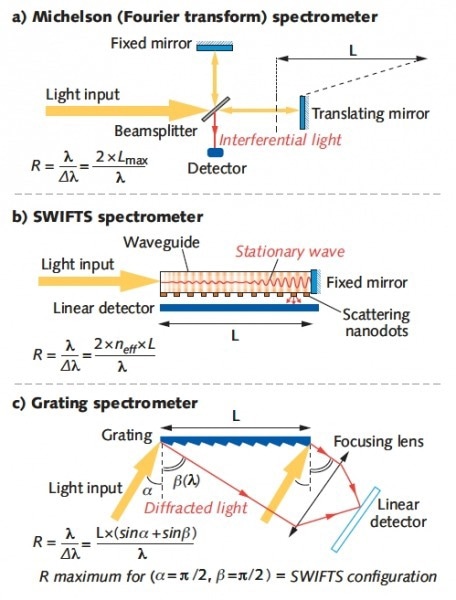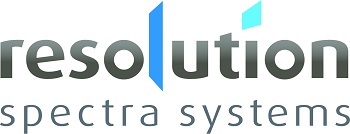For a specific resolving power even when very high, SWIFTS corresponds to the smallest grating configuration that can be found. SWIFTS is optimum of spectroscopic configurations and a new category of spectrometer avoiding classical trade-offs in spectroscopy.
There are different ways of using the SWIFTS principle in terms of functionalities. The measured rough data are in the Fourier domain and result from a linear optical path difference (OPD).
The time difference and the OPD are zero at the fixed mirror, this is where low Fourier frequencies are present. The further from the mirror the detected fringes are, the more they correspond to high OPD, high Fourier frequencies, high time difference and sharper spectral patterns.
SWIFT Chip Functionalities
The SWIFTS chip can be used as a spectrometer or an interferometer.
The chip can measure OPD or optical coherence tomography (OCT) signals directly in the spatial domain or read time correlation as an interferometer.
The chip is capable of optical signal characterization as a spectrometer when applying a Fourier-like function on the rough data or select Fourier frequencies, used to detect specific Fourier signatures.
SWIFTS may be considered as a static and condensed evolution of the Michelson spectrometer configuration where the detector and the moving mirror are both functionally replaced by the nanodetectors, each formed by a pixel and a nanodot.
The regular nanodot pattern can evoke a grating spectrometer. SWIFTS can be taken as optimizing the grating spectrometer configuration. As explained in Figure 1, a grating spectrometer is in fact also an interferometric system that creates an OPD between both sides of the grating.
Observations
Figure 1 compares the SWIFTS principle with grating spectrometers and Michelson.
The observations from the comparison are:
- A Fourier-transform spectrometer is shown in a Michelson configuration.
- A SWIFTS spectrometer is like a simplified Michelson interferometer in which the scanning mirror and the detector are replaced by the nanodetectors.
- A grating spectrometer is an interferometric system that creates an optical path difference (OPD) equal to L x (sinα + sinβ) between the rays reaching the two sides of the grating. For a given grating width L, the resolving power of the grating is maximum for two angles that correspond to the SWIFTS configuration (incident and diffracted light are aligned).

Figure 1.
About Resolution Spectra Systems
RESOLUTION Spectra Systems was set up in 2011 to develop an offer based on SWIFTS technology. Its founders are senior engineers, business managers and research scientists from the Joseph Fourier University of Grenoble in France. The company is also based in Grenoble, one of Europe’s leading high-technology centers.
RESOLUTION Spectra Systems is looking to revolutionize the use of spectrometers in the future. A combination of high performance, simplicity and compactness will allow SWIFTS-based spectrometers to be employed in configurations that were impossible for previous generations of spectrometer, opening up the use of high-performance spectroscopy to mainstream applications and enabling its integration with new or existing technologies.
The core benefits of SWIFTS, its compactness, portability and potential for integration, will provide real answers to current market requirements. This is particularly true for applications that require spectral discrimination with respect to molecular emission and absorption, including process control, laser spectroscopy for the analysis of materials, security and medical applications.
Our supply chain is based on processes developed in-house, but also on a smart scheme that takes advantage of the unique convergence of state-of-the-art technologies and facilities located in the Grenoble Cluster.
RESOLUTION Spectra Systems is developing several families of off-the- shelf spectrometers and is focusing its R&D efforts on tailoring solutions to applications that require a high level of performance, compactness, portability or simplicity.
RESOLUTION Spectra Systems is not only a powerful technology developer, it is also resolutely focused on serving customers and responding to their needs.

This information has been sourced, reviewed and adapted from materials provided by Resolution Spectra.
For more information on this source, please visit Resolution Spectra.